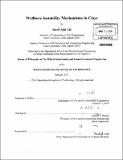Wellbore instability mechanisms in clays
Author(s)
Akl, Sherif Adel
DownloadFull printable version (39.55Mb)
Alternative title
Well bore instability mechanisms in clays
Other Contributors
Massachusetts Institute of Technology. Dept. of Civil and Environmental Engineering.
Advisor
Andrew J. Whittle.
Terms of use
Metadata
Show full item recordAbstract
This dissertation investigates the stability of wellbores drilled in Ko-consolidated clays using non-linear finite element method (FEM) and effective stress soil models to characterize the behavior of clay and unconsolidated shale formations. Two constitutive models are used: Modified Cam Clay (MCC; Roscoe and Burland, 1968), and MIT-E3 (Whittle and Kavvadas, 1994). These soil models are incorporated in the commercial finite element program ABAQUS TM through user material subroutines (Hashash, 1992). The wellbores are modeled by a quasi-3D finite element model to approximate the far field stresses and plane strain boundary conditions. The constitutive models are calibrated to the behavior of Resedimented Boston Blue Clay (RBBC), an analog shale material which is Ko-consolidated to stress levels ranging from 0.15MPa to 10.0 MPa. The thesis comprises three major parts. Part one analyzes the short-term wellbore instability during drilling in low permeability formations. The part focuses on the relationship between the mud pressure inside the wellbore and the undrained shear deformations within the formations. The analyses predict critical mud pressure values necessary to maintain wellbore stability at different deviation angles and stress histories. The MIT-E3 model predicted higher deformations at reference mud pressure and estimated higher values of mud pressures than the underbalanced limit to prevent failure in highly deviated wellbores in NC clays. The second part validates the numerical analyses by comparing model predictions to results of an extensive program of model borehole tests. The lab experiments are performed on high pressure Thick- Walled Cylinder (TWC devices) using RBBC as analog testing material (Abdulhadi, 2009). The MIT-E3 predictions demonstrated a very good match with results from the experiments. The results from the analyses illustrated the effect of the device boundary conditions on specimen behavior and validated approximate analytical methods for interpreting TWC results. Part three studies the effects of consolidation on long-term wellbore stability. Non-linear coupled consolidation analyses are performed to simulate the post-drilling, time-dependent deformations and pore pressures around the wellbore. The analyses consider two different boundary conditions on seepage at the cavity. The analyses show that consolidation generates extensive volumetric strains around the wellbore and cavity deformations can aggravate stability conditions in highly deviated wellbores.
Description
Thesis (Ph. D.)--Massachusetts Institute of Technology, Dept. of Civil and Environmental Engineering, February 2011. "February 2011." Cataloged from PDF version of thesis. Includes bibliographical references (p. 331-341).
Date issued
2011Department
Massachusetts Institute of Technology. Department of Civil and Environmental EngineeringPublisher
Massachusetts Institute of Technology
Keywords
Civil and Environmental Engineering.